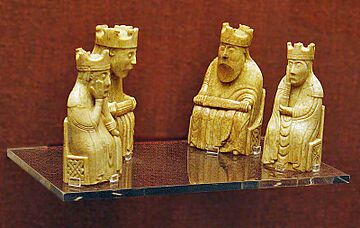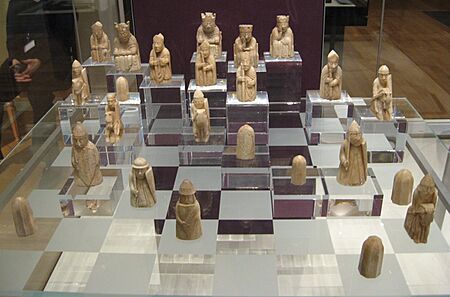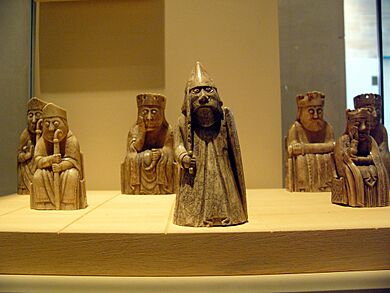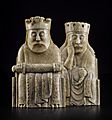Lewis chessmen facts for kids
Quick facts for kids Lewis chessmen |
|
|---|---|

Lewis chessmen in the British Museum
|
|
| Material | Walrus ivory and whales' teeth |
| Created | 12th century |
| Discovered | 1831 Uig, Lewis, Scotland |
| Present location | |
| NMS website entry | |
The Lewis chessmen (also called the Uig chessmen) are a famous collection of chess pieces from the 12th century. They were found in 1831 on the Isle of Lewis in Scotland. Most of these unique pieces are carved from the tusks of walruses.
When they were first found, there were 94 items. This included 78 chess pieces, 14 pieces for other board games like backgammon, and one belt buckle. Today, 82 of these pieces are kept at the British Museum in London. The other 11 pieces are at the National Museum of Scotland in Edinburgh. There is also at least one chess piece owned by a private collector.
In July 2019, a missing "warder" piece (which is like a rook in modern chess) was found and sold for a lot of money. This means that a few other main pieces and many pawns are still missing from the original sets.
Contents
Where the Chessmen Were Found
Most people say the chessmen were found at Uig Bay on the west coast of Lewis. However, some experts from the National Museums Scotland think they might have been found at Mealista. Mealista is also in the Uig area, but it's about 6 miles (10 km) further south.
After they were found, the collection was split up and sold. The British Museum bought 82 pieces. The National Museum of Scotland has 11 pieces. The recently found piece is now owned by a private collector.
At the British Museum, a scholar named F. Madden was very interested in the chessmen. He was a chess fan himself! He helped the museum buy the pieces and immediately started writing about them. His research is still helpful today.
What the Chessmen Look Like
Almost all the chess pieces are carved from walrus ivory. A few are made from whale teeth. There are 79 chess pieces in total. These include 8 kings, 8 queens, 16 bishops, 15 knights, 13 warders (rooks), and 19 pawns.
The pawns are the smallest pieces, ranging from about 1.4 to 2.3 inches (3.5 to 5.8 cm) tall. The other pieces are taller, between 2.75 and 4 inches (7 and 10.2 cm). Even though there are 19 pawns (a full set needs 16), they come in many different sizes. This makes experts think that the 79 chess pieces might actually belong to at least five different chess sets.
The pawns are simple, geometric shapes, like cylinders or "tombstones." The other pieces are carved to look like human figures. The knights are shown riding small horses and holding spears and shields. The rooks, or "warders," are standing soldiers with shields and swords. Four of the warders are shown as wild-eyed "berserkers." These berserkers are biting their shields, showing how fierce they were in battle!
When the chessmen were found, some had traces of red color. This suggests that the two sides in the game might have been red and white, instead of the black and white we use today.

Many people today find the chessmen's expressions quite funny. They have bulging eyes and serious or worried faces. One rook, in particular, has a worried, sideways glance. The berserker rooks biting their shields also look very amusing to us now. However, it's believed that the people who made them didn't mean for them to look funny or sad. Instead, they probably saw strength, fierceness, or wisdom in these carvings. For example, the queens hold their heads with a hand, looking thoughtful.
The king pieces have beards, hairstyles, and facial features that would have been common in 12th-century Norway. This fits with the idea that the chess sets might have come from Norway.
How They Were Found
The chessmen were found in early 1831 in a sandbank. This was at the head of Uig Bay on the west coast of the Isle of Lewis. There are different local stories about how they got there and how they were discovered.
A man named Malcolm "Sprot" MacLeod found the treasure. It was hidden in a small stone box in a sand dune. He showed them briefly in his barn before selling them to Captain Roderick Ryrie. One story says a cow actually dug them up, but people in Uig usually say that's not true.
When the chessmen were found in 1831, one knight and four warders were missing from the four sets. In June 2019, a warder piece that had been lost for at least 55 years was found in Edinburgh. It was sold at an auction for £735,000 the next month.
Where You Can See Them
After their discovery, the chessmen were shown at a meeting of the Society of Antiquaries of Scotland in April 1831. Soon after, the collection was split up. Ten pieces were bought by C.K. Sharpe. The rest (67 chessmen and 14 game pieces) were bought for the British Museum in London.
C.K. Sharpe later found another bishop, bringing his collection to 11 pieces. These were later sold to Baron Londesborough. In 1888, these 11 pieces were sold again, this time to the Society of Antiquaries of Scotland. They then gave the pieces to the Royal Scottish Museum in Edinburgh. These 11 pieces are now on display at the National Museum of Scotland.
Most of the pieces given to the British Museum can be found in Room 40. Some have also been loaned to Scottish museums and special exhibitions. You can also find wooden or plastic copies of the chessmen in museum shops.
The Lewis chessmen were featured in a 2003 BBC documentary about important British archaeological finds. They were also part of a 2010 BBC Radio 4 series about history.
There have been several special exhibitions of the chessmen. An exhibition called "The Lewis Chessmen: Unmasked" included pieces from both the National Museum of Scotland and the British Museum. It opened in Edinburgh in May 2010 and then traveled to Aberdeen, Shetland, and Stornoway.
Another exhibition, "The Game of Kings: Medieval Ivory Chessmen from the Isle of Lewis," was held at The Cloisters in New York City. It featured 34 chess pieces loaned from the British Museum and lasted until April 2012.
In April 2013, money was given to turn Lews Castle on the Isle of Lewis into a museum for the Western Isles. The Museum nan Eilean, located on the castle grounds, now displays six Lewis chessmen on loan from the British Museum.
In 2023, the Edinburgh warder piece was shown at the Neue Galerie New York as part of a special exhibit.
Debate Over Their Home

Since late 2007, there has been a discussion about where the main collection of the chessmen should be kept. Some politicians in Scotland, especially from the Western Isles, believe the pieces should be returned to the place where they were found. They argue that it's not right for only 11 pieces to be in Scotland while most of them are in the British Museum in London.
However, officials from the British Museum disagree. They say that the law protects their ownership of the pieces. They also compare it to other famous artworks that are kept in major cities around the world. The local historical society in Uig, where the chessmen were found, has a museum with information about them. They welcome short-term loans of the pieces but don't claim to own them.
In October 2009, 24 pieces from London and 6 from Edinburgh went on a 16-month tour of Scotland. The Scottish Government helped fund this tour. The British Museum and the Scottish Government "agreed to disagree" on where the pieces should eventually stay. The museum's deputy chairman said she strongly believed the main collection should remain in London.
The director of the British Museum at the time, Neil MacGregor, even suggested that Norway might have a claim to the pieces, not Scotland. However, six of the figures were loaned long-term to Lewis's new museum in 2015.
-
Selection of chessmen at NMS
-
King and Queen at NMS
-
Row of bishops at the back and then knights, among a selection pieces on display at BM
-
Knight on a stout pony
-
Decoration carved on back of a queen's throne at BM
See also
 In Spanish: Ajedrez de la isla de Lewis para niños
In Spanish: Ajedrez de la isla de Lewis para niños
- Charlemagne chessmen









